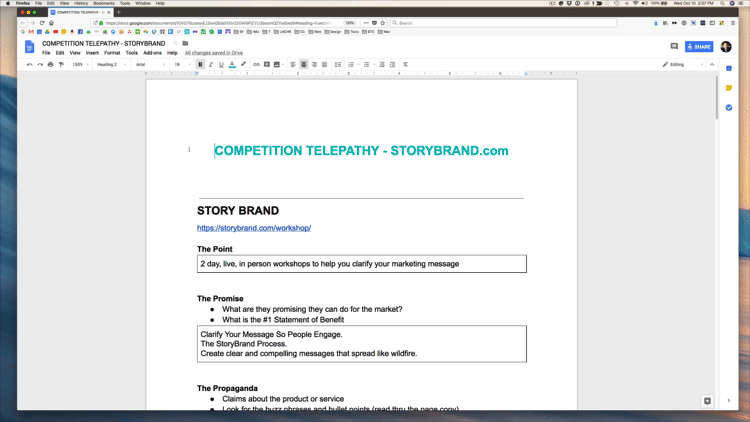Competition Telepathy™ – The 11 Step Method To Gain An Unfair Advantage In Your Marketplace
Get a leg up by perusing your top three competitors across all the platforms on which they play! Here’s a systematic way to collect priceless data from competitors in your space.

Your Top Competitors:
Pick three brands already successful in the market you want to reach. Pick companies that are where you aspire for your brand to be within a year.
Not 10 years. Not 5 years. 1 year from now. Do NOT choose the BIGGEST player in your industry unless you can honestly catch up to them within a year.
As cooperative capitalists, we understand that making a list of your competitors may feel adversarial, so let’s dismantle that before we begin by stating that this process is designed to help you WIN with your audience, NOT win over the audience of your competitors.
The 11 Steps:
Collect the answers to these 11 questions for each of the three brands in a spreadsheet or document. Your choice.
Step 01. THE POINT
In broad strokes (and under 25 words) what does this brand do?
Step 02. THE PROMISE
What do they promise they can do? What benefit are they stating they can provide? What is unique about their main benefit that clients or customers couldn’t get elsewhere?
Step 03. THE PROPAGANDA
What buzz phrases, bullet points and/or claims does the brand make about their offers, services or products?
Step 04. THE PRODUCTS
What is the offer progression of the brand? What do they offer prospects as an entry-level offer? What are the low, mid, high and premium offers? Be sure to examine how they relieve risk for buyers. Is the guarantee unconditional or only for a certain number of days? Is the guarantee based on any qualifications? How is it phrased?
Step 05. THE PROCESS
What’s the ‘delivery mechanism’ for fulfilling on the brand promise? What’s unique and different about the process? What’s their unfair advantage? What do they use for their product or service delivery? Are there live elements to the delivery? If so, are they one-on-one or in group format? Do they provide forums or groups?
Step 06. THE PROOF
Look at all the testimonials, endorsements, and proof points you can. Read them. Watch the video testimonials. Look at any before or after photos. Are there case-studies to review? Listen and read with the intent to gain deep empathy for the emotional pains and desired gains of the market.
Step 07. THE PULL
What does the brand give away for free to capture an email address or phone number? What types of lures (lead magnets) are they using? Do they have eBooks, checklists, cheat sheets, free trainings, videos, webinars or audio downloads? Create links to their landing pages for their lures and add them to your marketing ideas Swipe File.
Step 08. THE PLATFORMS
What social media platforms are they using the most? List out the channels. Note topics covered, what posts get the most engagement, what is the frequency of posting and types of messaging used. Take notes on engagement and shares. Scope out what their leads and customer are saying in the comments and look for patterns and big ideas.
Step 09. THE PLAN
Now that you’ve reviewed their social platforms… What’s their content marketing plan? How do they use social-to-list conversion? What do you like and dislike about their content and social platform strategy?
Step 10. THE PROMOTIONS
What paid ads are they running on Facebook? Have you signed up for their newsletter or email list to see what promotions they are sending to their list? How often do they offer sales or discounts? What ads are they using for retargeting in display networks? What banner ads to they have on their website and blog?
Step 11. THE PARTNERSHIPS
What partnership opportunities is the brand engaging in? Are they interacting with the local community? What events are they sponsoring? What charities do they support? Do they have affiliate partners sending emails for them? What affiliate partners is the brand promoting? Does the brand have an affiliate program and if so what is the affiliate split or payment structure? Does the brand have sponsors for their events?
Here’s an example we performed for a past client who said ‘Storybrand’ was one of their top 3 competitors:

The Analysis:
Finally, Assimilate the data you collected to form a plan to alter your path for the better.
With all the data you just collected organized and in front of you and your top executives or advisors, look for what I call ‘patterns in the matrix‘.
Look for where you can outshine the competition and make sure those strengths are accentuated in your marketing and offers.
Look for where the competition outshines you and glean insight into what you might want to consider modeling or improving for your content, products, and offers so you can continue to delight and deliver on the value you deliver.
Here’s a list of just some of what I consider when performing this process for our clients.
- Where do you have a competitive advantage? What’s better about your offer? Is that accentuated in your marketing?
- Where can you play a bigger game? Is there a wide open field on a particular social media platform?
- What is revealed when examining fee structures? Is there an opportunity to make an offer at a particular price point?
- How high or low touch is the delivery of their process? Is there a concierge version to offer or something more DIY?
- Are you catering to a different personality style or sector of the market? Is that clear and are you on the appropriate platforms for the audience you want to reach?
There you have it! That’s how you perform Competition Telepathy.
If you’d like the insight without all the work, you can schedule a time to talk with Travis about the Foundational Marketing Package which includes our team doing Customer Telepathy, Content Telepathy and Competition Telepathy and assimilating it all into a suggested plan of action for your brand.




